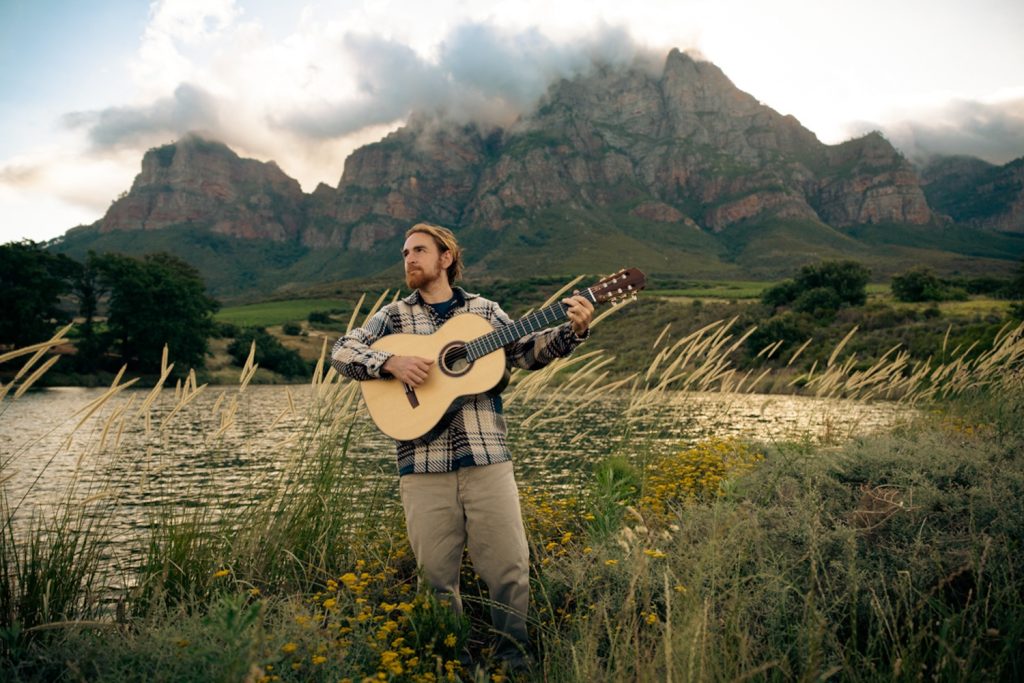(Seth Tabatznik / Image Credit: Timmy Henny)
In the hazy afterglow of his latest drop, Seth Tabatznik is proving that indie folk’s next heartbeat comes straight from the earth—raw, reverent, and unapologetically alive. Just a few days ago on October 10, this London-raised troubadour, now hunkered down in South Africa’s breathtaking Western Cape mountains, unveiled ‘Choose To Be Alive’ through Moth Music, a stripped-down gem of acoustic strums, shaker pulses, and that ethereal flute weave that nods to Vance Joy‘s wanderlust and Paul Simon‘s intricate soul, all while channeling his mentor Nick Mulvey‘s guiding hand on the guitar work shaped by Rainer Scheurenbrand. Since debuting in 2024, he’s clocked over 100,000 streams, packed houses at Boschendal Estate in Cape Town and Green Note in Camden, and snagged early buzz from CLASH Magazine—all pointing to a sophomore album brewing for 2026 that could redefine medicine-tinged folk for a generation craving roots amid the rush.
As Seth Tabatznik bridges ancient earth whispers with modern grit, we caught up with him to unpack the meditations fueling this track and the path that’s got us hooked.
What’s one unexpected thing about growing up in London that still sneaks into your songwriting today?
There are so many sides to London and I’m always proud to know what a green city it is compared to so many others I’ve visited around the world. I’d say it’s those beautiful pockets of nature that have stayed with me. I spent a lot of time in the parks as a kid, playing sports, being outdoors and just soaking up the elements. The fact that nature can still be so abundant, with trees often dominating the skyline, reminds me that nature is almighty, even in an urban world.
How has trading the buzz of Camden for the quiet of South Africa’s Western Cape mountains shifted the way you approach your music?
It’s been completely transformative. In London, life felt full, stimulating, but intense. Here, surrounded by mountains, rivers, and sun, I’ve learned to create from stillness rather than striving. Nature doesn’t rush, and that’s changed everything about how I write. Songs now emerge more intuitively, not forced but found. It’s become less about performance and more about communion.
With sold-out shows at places like Boschendal Estate and Green Note under your belt already, what’s the live moment that’s stuck with you the most from those early gigs?
Boschendal was my first ever live show, so stepping onto that stage felt like crossing a threshold, a real “yes” to this path. My first UK show at GreenNote was equally special. It’s such an intimate venue that you can feel every person in the room. People sang along and it wasn’t about me performing, it was about all of us remembering something together. That’s the feeling I love most and why I love being on stage — to bring people together.
You mention weaving in medicine music with your acoustic folk—how do you decide when a song needs that extra layer of earth-bound reverence?
I think all music can be received as medicine, especially when a song feels like it wants to open hearts rather than just entertain. My music always carries a message; it’s not frivolous, it’s intentional. A lot of my friends and musical community, including my guitar teacher, are more in the “medicine music” world and I love that, but I see myself as more of a bridge. I’m stepping into the acoustic folk world while holding the intention that the music should be healing and transformative in some form. For me, medicine music is about resonance, not genre. It’s a sound used in service of connection.
Nick Mulvey’s mentorship clearly left its mark on your upcoming album; what was the best piece of advice he dropped that changed how you write?
I’ve known Nick for a while and always looked up to him as an inspiration in the music world. He was one of the first people I reached out to for advice when I started releasing. His wisdom and experience really helped shape many of the tracks on my upcoming, but probably the best advice was also the simplest. On a few songs that weren’t quite feeling right, he pointed me towards the tempo, encouraging me to play with more variation. That one small tip completely transformed the album from something quite ordinary in the demo stage to something I now believe is world-class.
‘Choose To Be Alive’ feels like a direct line from your daily meditations—what’s a specific routine in Dr. Joe Dispenza’s method that sparked the lyrics?
Choose To Be Alive is really an embodiment of the message that Dr. Joe teaches — that we are the creators of our lives, and that gratitude is the highest state of being for manifesting our reality. If you listen carefully to the lyrics, it’s all about thanking ourselves for the life we’ve chosen and feeling connected to it all, especially when we go within. I meditate every day for between 30 and 75 minutes, focusing on gratitude and coherence, and that practice has changed my life in so many beautiful ways.
That flute solo in ‘Choose To Be Alive’ cuts right through the harmonies—how did you land on it as the perfect breath of mysticism for the track?
The flute is played by Dr. Bridget Rennie Salonen, who lives in Stellenbosch and works with music as a healing modality. I knew I wanted that kind of energy on the track, something that could bridge sound and spirit. Bridget understood it immediately. Her flute became the breath of the song, like a guide bringing you home to yourself.
The song’s all about ditching victimhood for creator energy, but in your own life, what’s been the toughest habit to break when it comes to owning your actions?
Probably the illusion of control — the old story that if I just push harder, I can shape everything. Letting go of that has been the hardest practice and it’s still one I’m working on because it’s so deeply ingrained. I know that I can create reality from the field of consciousness, because I’ve done it before, but it’s easy to get caught up in the doing instead of the being. After all, we’re human beings, not human doings.
With over 100,000 streams this fast and a second album on the horizon for 2026, how are you navigating the pressure of being the indie folk artist everyone’s suddenly watching?
I don’t feel any pressure around my music because it’s a choice I make every day. The fact that people are listening at all feels like a gift. Awakening Embers, my second album coming in February 2026, feels like a continuation and deepening of this unfolding. The focus for me is staying truthful, not trend-driven. My compass is integrity, and I’ve surrounded myself with amazing people who remind me who I am and why I’m doing this.
If you could teleport Vance Joy or Paul Simon to one of your mountain writing sessions right now, who gets the invite and what track do you play first to break the ice?
That’s a tough one. I’d probably choose Paul Simon. He’s always managed to weave joy and wisdom so beautifully, and I grew up singing his songs. A lot of people reference him when they talk about my music. I’d love to take Paul into the forest where I often write and share my newest track, Choose To Be Alive, because it’s what feels most alive for me right now. There are lots of beautiful spaces for harmonies and that’s what brings my songs to life.
Stream ‘Choose To Be Alive‘:
Follow Seth Tabatznik:
Website – Instagram – Facebook – Soundcloud – TikTok – Youtube – Spotify



Leave a reply